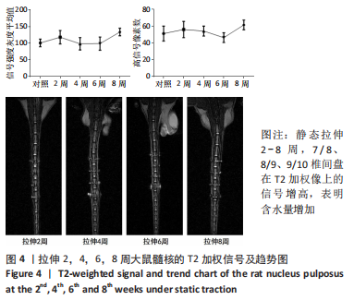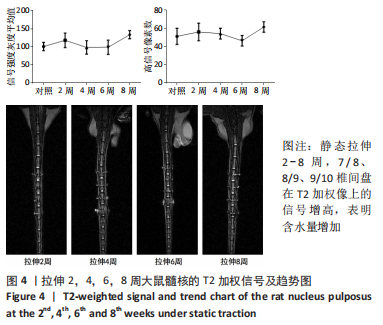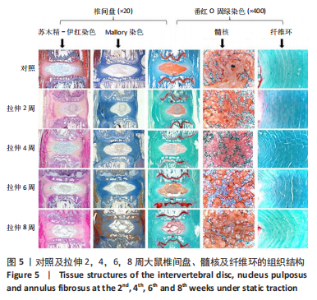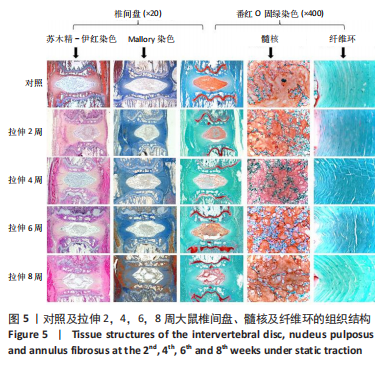Chinese Journal of Tissue Engineering Research ›› 2024, Vol. 28 ›› Issue (8): 1180-1185.doi: 10.12307/2023.995
Previous Articles Next Articles
Effects of static traction on the nucleus pulposus and annulus fibrosus of the rat intervertebral disc
Mo Jun1, Luo Zongping2
- 1Jiangsu Institute of Parasitic Diseases, Wuxi 214064, Jiangsu Province, China; 2Orthopedic Institute, the First Affiliated Hospital of Soochow University, Suzhou 215006, Jiangsu Province, China
-
Received:2022-11-28Accepted:2023-02-04Online:2024-03-18Published:2023-07-18 -
Contact:Luo Zongping, MD, Professor, Orthopedic Institute, the First Affiliated Hospital of Soochow University, Suzhou 215006, Jiangsu Province, China -
About author:Mo Jun, Master, Physician, Jiangsu Institute of Parasitic Diseases, Wuxi 214064, Jiangsu Province, China
CLC Number:
Cite this article
Mo Jun, Luo Zongping. Effects of static traction on the nucleus pulposus and annulus fibrosus of the rat intervertebral disc[J]. Chinese Journal of Tissue Engineering Research, 2024, 28(8): 1180-1185.
share this article
Add to citation manager EndNote|Reference Manager|ProCite|BibTeX|RefWorks
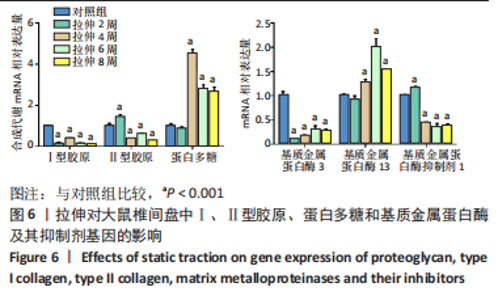
2.4 基因检测结果 基因检测显示,静态拉伸使得椎间盘中蛋白多糖的表达增加。与未被静态拉伸的椎间盘相比,拉伸2周时,Ⅰ型胶原和MMP-3表达下降(P < 0.001),Ⅱ型胶原和TIMP-1表达上升(P < 0.001),蛋白多糖和MMP-13略有下降但差异无显著性学意义;拉伸4周时,Ⅰ型胶原和MMP-3表达下降(P < 0.001),TIMP-1、Ⅱ型胶原表达下降(P < 0.001),MMP-13、蛋白多糖表达上升(P < 0.001);拉伸6周时,Ⅰ型胶原和MMP-3表达下降(P < 0.001),Ⅱ型胶原和TIMP-1表达下降(P < 0.001),蛋白多糖和MMP-13表达上升(P < 0.001);拉伸8周时,Ⅰ型胶原和MMP-3表达下降(P < 0.001),Ⅱ型胶原和TIMP-1表达下降(P < 0.001),蛋白多糖和MMP-13表达上升(P < 0.001)(图6)。总结上面的结果可知,短期拉伸之后,蛋白多糖基因表达升高,MMP-3表达降低,Ⅰ、Ⅱ型胶原基因表达降低,MMP-13、TIMP-1表达升高,这些基因结果也进一步表明拉伸使得蛋白多糖更趋向合成代谢状态,Ⅰ、Ⅱ型胶原更趋向于分解代谢状态。"
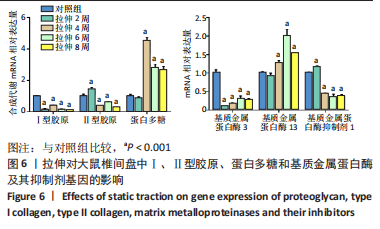
| [1] PFIRRMANN CWA, METZDORF A, ZANETTI M, et al. Magnetic resonance classification of lumbar intervertebral disc degeneration. Spine. 2001; 26:1873-1878. [2] WANG H, JIANG Z, PANG Z, et al. Acacetin alleviates inflammation and matrix degradation in nucleus pulposus cells and ameliorates intervertebral disc degeneration in vivo. Drug Des Dev Ther. 2020;14: 4801-4813. [3] QIN R, DAI S, ZHANG X, et al. Danshen Attenuates Intervertebral Disc Degeneration via Antioxidation in SD Rats.Oxid Med Cell Longev. 2020; 2020:1-12. [4] LI K, LV C. Intradiscal injection of sesamin protects from lesion-induced degeneration. Connect Tissue Res. 2019;61(6):594-603. [5] CHE YJ, HOU JJ, GUO JB, et al. Low energy extracorporeal shock wave therapy combined with low tension traction can better reshape the microenvironment in degenerated intervertebral disc regeneration and repair. Spine J. 2021;21(1):160-177. [6] DAI S, SHI X, QIN R, et al. Sodium Tanshinone IIA Sulfonate Ameliorates Injury-Induced Oxidative Stress and Intervertebral Disc Degeneration in Rats by Inhibiting p38 MAPK Signaling Pathway. Oxid Med Cell Longev. 2021;2021:1-12. [7] SCHMIDT H, REITMAIER S, GRAICHEN F, et al. Review of the fluid flow within intervertebral discs - How could in vitro measurements replicate in vivo? J Biomech. 2016;49(14):3133-3146. [8] LIU ZZ, WEN HQ, ZHU YQ, et al. Short-Term Effect of Lumbar Traction on Intervertebral Discs in Patients with Low Back Pain: Correlation between the T2 Value and ODI/VAS Score. Cartilage. 2021;13(1):414-423. [9] GUO JB, CHE YJ, HOU JJ, et al. Stable mechanical environments created by a low-tension traction device is beneficial for the regeneration and repair of degenerated intervertebral discs. Spine J. 2020;20(9):1503-1516. [10] MO Z, ZHANG R, CHEN J, et al. Comparison Between Oblique Pulling Spinal Manipulation and Other Treatments for Lumbar Disc Herniation: A Systematic Review and Meta-Analysis. J Manip Physiol Ther. 2018; 41(9):771-779. [11] ASIRI F, TEDLA JS, MS DA, et al. Effects of patient-specific three-dimensional lumbar traction on pain and functional disability in patients with lumbar intervertebral disc prolapse. Niger J Clin Pract. 2020;23(4):498-502. [12] ZHANG YH, ZHAO CQ, JIANG LS, et al. Lentiviral shRNA silencing of CHOP inhibits apoptosis induced by cyclic stretch in rat annular cells and attenuates disc degeneration in the rats. Apoptosis. 2011;16(6): 594-605. [13] KUO YW, HSU YC, CHUANG IT, et al. Spinal traction promotes molecular transportation in a simulated degenerative intervertebral disc model. Spine (Phila Pa 1976). 2014;39(9):550-556. [14] ALIBEGOVIĆ A, BLAGUS R, MARTINEZ IZ. Safranin O without fast green is the best staining method for testing the degradation of macromolecules in a cartilage extracellular matrix for the determination of the postmortem interval. Forensic Sci Med Pat. 2019;16(2):252-258. [15] HU S, ZHANG C, NI L, et al. Stabilization of HIF-1α alleviates osteoarthritis via enhancing mitophagy. Cell Death Dis. 2020;11(6): 481-496. [16] ZHANG J, WANG L, ZHANG W, et al. Synchronization of calcium sulphate cement degradation and new bone formation is improved by external mechanical regulation. J Orthop Res. 2015;33(5):685-691. [17] FAGGIOLI F, LUIGI M. Multiplex RT-PCR. Methods Mol Biol. 2022;2316: 163-179. [18] BACHMAN J. Reverse-Transcription PCR (RT-PCR). Methods Enzymol. 2013;530:67-74. [19] LUO Y, ZHANG L, WANG WY, et al. Alendronate retards the progression of lumbar intervertebral disc degeneration in ovariectomized rats. Bone. 2013;55(2):439-448. [20] MADHAVAN S, ANGHELINA M, RATH-DESCHNER B, et al. Biomechanical signals exert sustained attenuation of proinflammatory gene induction in articular chondrocytes. Osteoarthritis Cartilage. 2006;14(10): 1023-1032. [21] NAM J, RATH B, KNOBLOCH TJ, et al. Novel electrospun scaffolds for the molecular analysis of chondrocytes under dynamic compression. Tissue Eng. 2009;15:513-523. [22] XIN J, WANG Y, ZHENG Z, et al. Treatment of Intervertebral Disc Degeneration. Orthop Surg. 2022;14(7):1271-1280. [23] CHOW DHK, YUEN EMK, XIAO L, et al. Mechanical effects of traction on lumbar intervertebral discs: A magnetic resonance imaging study. Musculoskelet Sci Pract. 2017;29:78-83. [24] KULIGOWSKI T, DEBIEC-BAK A, SKRZEK A. Effectiveness of Traction in Young Patients Representing Different Stages of Degenerative Disc Disease. Ortop Traumatol Rehabil. 2019;21(3):187-195. [25] CHE YJ, GUO JB, HAO YF, et al. Regenerating and repairing degenerative intervertebral discs by regulating the micro/nano environment of degenerative bony endplates based on low-tension mechanics. BMC Musculoskelet Disord. 2022;23(1):462-474. [26] CHANG HI, CHEN CN, HUANG KY. Mechanical Stretch-Induced NLRP3 Inflammasome Expression on Human Annulus Fibrosus Cells Modulated by Endoplasmic Reticulum Stress. Int J Mol Sci. 2022;23(14):7951-7962. [27] TERAHATA N, ISHIHARA H, OHSHIMA H, et al. Effects of axial traction stress on solute transport and proteoglycan synthesis in the porcine intervertebral disc in vitro. Eur Spine J. 1994;3:325-330. [28] LAI A, CHOW DHK. Effects of traction on structural properties of degenerated disc using an in vivo rat-tail model. Spine. 2010;35:1339-1345. [29] HAN C, MA XL, WANG T, et al. Low magnitude of tensile stress represses the inflammatory response at intervertebral disc in rats. J Orthop Surg Res. 2015;10:26-33. [30] HUTTON WC, YOON ST, ELMER WA, et al. Effect of tail suspension(or simulated weightlessness) on the lumbar intervertebral disc. Spine. 2002;27:1286-1290. [31] CHE YJ, LI HT, LIANG T, et al. Intervertebral disc degeneration induced by long-segment in-situ immobilization: a macro, micro, and nanoscale analysis. BMC Musculoskelet Disord. 2018;19(1):308-317. [32] LIANG T, ZHONG DY, CHE YJ, et al. Nano and micro biomechanical analyses of the nucleus pulposus after in situ immobilization in rats. J Orthop Res. 2020;37(1):232-238. [33] CHE YJ, GUO JB, LIANG T, et al. Controlled immobilization-traction based on intervertebral stability is conducive to the regeneration or repair of the degenerative disc: an in vivo study on the rat coccygeal model. Spine J. 2019;19(5):920-930. [34] CHE YJ, GUO JB, LIANG T, et al. Assessment of changes in the micro-nano environment of intervertebral disc degeneration based on Pfirrmann grade. Spine J. 2019;19:1242-1253. [35] XIA W, ZHANG L L, MO J, et al. Effect of Static Compression Loads on Intervertebral Disc: An in Vivo Bent Rat Tail Model. Orthop Surg. 2018;10(2):134-143. [36] ANNOVAZZI L, GENNA F. An engineering, multiscale constitutive model for fiber-forming collagen in tension. J Biomed Mater Res A. 2010;92(1):254-266. [37] FRANCHI M, OTTANI V, STAGNI R, et al. Tendon and ligament fibrillar crimps give rise to left-handed helices of collagen fibrils in both planar and helical crimps. J Anat. 2010;216(3):301-309. [38] KO JH, KANG YM, YANG JH, et al. Regulation of MMP and TIMP expression in synovial fibroblasts from knee osteoarthritis with flexion contracture using adenovirus-mediated relaxin gene therapy. Knee. 2019;26(2):317-329. [39] NAGASE H, VISSE R, MURPHY G. Structure and function of matrix metalloproteinases and TIMPs. Cardiovasc Res. 2006;69(3):562-573. [40] HUANG D, PENG Y, MA K, et al. Puerarin Relieved Compression-Induced Apoptosis and Mitochondrial Dysfunction in Human Nucleus Pulposus Mesenchymal Stem Cells via the PI3K/Akt Pathway. Stem Cells Int. 2020;2020:1-16. |
| [1] | Liu Xin, Hu Man, Zhao Wenjie, Zhang Yu, Meng Bo, Yang Sheng, Peng Qing, Zhang Liang, Wang Jingcheng. Cadmium promotes senescence of annulus fibrosus cells via activation of PI3K/Akt signaling pathway [J]. Chinese Journal of Tissue Engineering Research, 2024, 28(8): 1217-1222. |
| [2] | Kang Zhijie, Cao Zhenhua, Xu Yangyang, Zhang Yunfeng, Jin Feng, Su Baoke, Wang Lidong, Tong Ling, Liu Qinghua, Fang Yuan, Sha Lirong, Liang Liang, Li Mengmeng, Du Yifei, Lin Lin, Wang Haiyan, Li Xiaohe, Li Zhijun. Finite element model establishment and stress analysis of lumbar-sacral intervertebral disc in ankylosing spondylitis [J]. Chinese Journal of Tissue Engineering Research, 2024, 28(6): 840-846. |
| [3] | Cao Sheng, Kong Lingwei, Xu Kun, Sun Zhijie. Effect of gelatin methacryloyl hydrogel loaded with salvianolic acid B on intervertebral disc degeneration [J]. Chinese Journal of Tissue Engineering Research, 2024, 28(3): 380-386. |
| [4] | Zhou Shuliang, Xu Liang, Qian Xuefeng, Zeng Jincai, Zhu Lifan. Correlation between the expression of miRNA-142-3p, mixed lineage kinase 3 and interleukin-1beta in nucleus pulposus and the degree of lumbar intervertebral disc degeneration [J]. Chinese Journal of Tissue Engineering Research, 2024, 28(2): 165-171. |
| [5] | Wang Qian, Lu Ziang, Li Lihe, Lyu Chaoliang, Wang Meng, Zhang Cunxin. Sinomenine effectively inhibits interleukin-1beta-induced apoptosis in nucleus pulposus cells [J]. Chinese Journal of Tissue Engineering Research, 2024, 28(2): 224-230. |
| [6] | Lian Shilin, Zhang Yan, Jiang Qiang, Zhang Hanshuo, Li Tusheng, Ding Yu. Interventional effects of whole blood and platelet-rich plasma with different preparation methods on nucleus pulposus cells [J]. Chinese Journal of Tissue Engineering Research, 2023, 27(8): 1199-1204. |
| [7] | Xiong Zhilin, Sun Hong, Liu Miao, Zhuang Yong. Roles of ferroptosis in intervertebral disc degeneration and osteoarthritis [J]. Chinese Journal of Tissue Engineering Research, 2023, 27(36): 5884-5890. |
| [8] | Sun Xiaoxian, Bai Xue, Liu Mengmin, Guo Yang, Lin Shun, Wu Wenxuan, Ma Yong, Liu Jintao. Establishing a rat model of intervertebral disc degeneration by castration of both upper limbs combined with intervertebral disc puncture [J]. Chinese Journal of Tissue Engineering Research, 2023, 27(35): 5616-5621. |
| [9] | You Yan, Chen Jiawen, Lin Binbin, Wu Jingyi, Liu Peng, Wu Buling, Sun Tianyu. Mechanism and application of glycosaminoglycan in bone tissue engineering [J]. Chinese Journal of Tissue Engineering Research, 2023, 27(34): 5538-5545. |
| [10] | Wu Hao, Ye Dongping. Application of single-cell RNA sequencing in intervertebral disc degeneration [J]. Chinese Journal of Tissue Engineering Research, 2023, 27(33): 5370-5371. |
| [11] | Liu Xin, Sun Tianze, Zhang Jing, Zhang Wentao, Li Zhonghai. Research and advance in intervertebral disc annulus fibrosus repair [J]. Chinese Journal of Tissue Engineering Research, 2023, 27(31): 5078-5084. |
| [12] | Zhang Hui, Wang Jiayang, Wang Qian, Gan Hongquan, Wang Zhiqiang. Effects of hyaluronic acid combined with domestic porous tantalum on chondrocyte function under the dynamic environment [J]. Chinese Journal of Tissue Engineering Research, 2023, 27(3): 339-345. |
| [13] | Zhang Wenjie, Zhang Yong, Shi Ming, Tang Guangjun, Shi Pengzhi, Wang Junwu, Hu Man, Wang Pingchuan, Zhang Liang. Icariin regulates apoptosis of nucleus pulposus-derived mesenchymal stem cells to repair intervertebral disc degeneration [J]. Chinese Journal of Tissue Engineering Research, 2023, 27(24): 3803-3809. |
| [14] | Zhang Weiye, Zhan Jiawen, Zhu Liguo, Wang Shangquan, Chen Ming, Wei Xu, Feng Minshan, Yu Jie, Han Tao, Cai Chuhao, Zhou Shuaiqi, Shao Chenchen. Effect of nucleus pulposus cells-derived exosomes under cyclic mechanical tension on endplate chondrocytes [J]. Chinese Journal of Tissue Engineering Research, 2023, 27(2): 223-229. |
| [15] | Zhang Haobo, Zhao Yunan, Yang Xuejun. Role and therapeutic implications of pyroptosis in intervertebral disc degeneration [J]. Chinese Journal of Tissue Engineering Research, 2022, 26(9): 1445-1451. |
| Viewed | ||||||
|
Full text |
|
|||||
|
Abstract |
|
|||||
